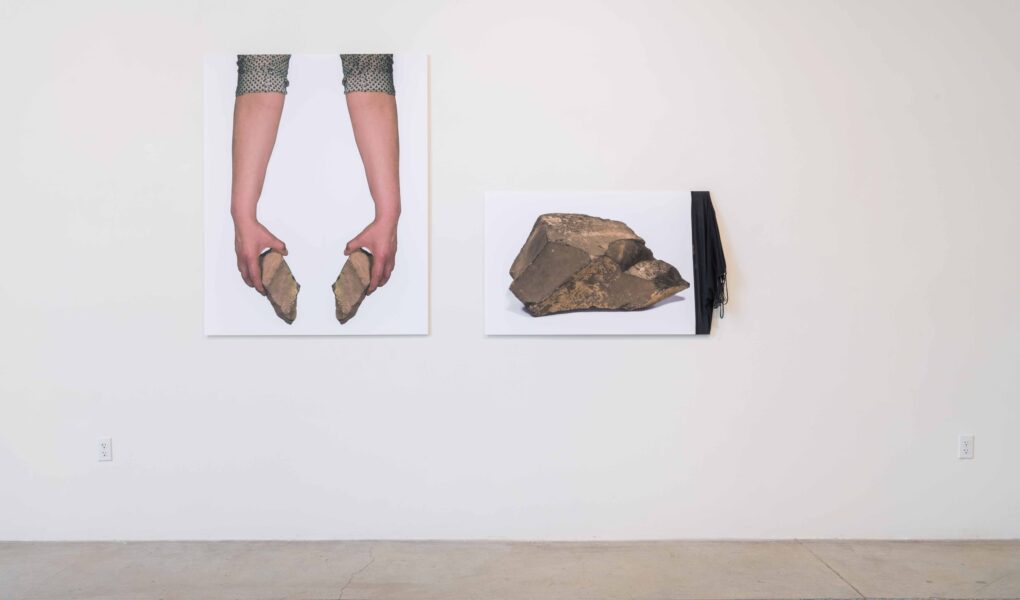Tannaz Farsi, “The Points of Departure,” Installation View, Linfield Gallery, McMinnville, Oregon, March 22 – April 29, 2017. Curated by Josephine Zarkovich.
The Points of Departure
In an ambitious new solo exhibition, Tannaz Farsi weaves together three works that articulate different moments within the history of Iranian visual culture. Exploring the semiotic richness of specific traditional iconographies, the artist sets their interpretation as a reflection upon the present.
The Points of Departure features a series of large scale works, including an expansive linear structure drafted from a 15th century drawing of a polygonal and star pattern found in The Topkapi Scroll, an architectural booklet attributed to the central or western region of Iran. While some examples of the scroll patterns can be found in existing buildings, the scroll was most likely a booklet of potential forms due to a lack of direct examples found in remaining architecture of the time. The artist became interested in the specific lineage of these patterns as a historical code and as a means of entering a speculative relationship around scientific, political and aesthetic means of power specific to time and place within the region.
In the second work, the artist has collected the names of Iranian women, historical and contemporary, to create a visible and accountable document of women’s public intellectual labor in Iran and abroad. The font that she created for the alphabet is influenced by a stacking square form that was introduced in the 10th century as a system of measurement in Arabic calligraphy. This means of creating a “proportioned script” was used to create consistency and repeatability of text. This work is counterposed with the image of the artist’s hand with a remnant of a column collected at Persepolis, the dynastic center of the Achaemenid kings and a site that lacks physical representation of women within its monuments and relief sculptures.
Finally, the exhibition includes an arrangement of 1,000 live tulips. The tulip is a potent and complex symbol in Iranian culture, having been used to represent martyrdom, renewal and opposition. Planted specifically for The Points of Departure at the turn of spring equinox, the tulips move through their cycle of regeneration, to grow, bloom and change throughout the exhibition.
For over a decade, the artist has been working in a variety of media to create powerful installations and projects that address the politics of nationhood and diasporic identity. Linfield Gallery is commemorating Farsi’s work by publishing a significant catalog that brings together documentation of her previous work alongside images from The Points of Departure and includes two newly-commissioned essays.
This exhibition is sponsored by the Lacroute Art Series and the Department of Art and Visual Culture. The Lacroute Arts Series at Linfield College is made possible by the generosity of Ronni Lacroute, Linfield College trustee and arts benefactor. The series, sponsored by the Lacroute Arts Fund at Linfield College, is dedicated to helping the college present art events and activities for the campus and community. It provides programs featuring artists in the areas of music, art and visual culture, and theatre and communication arts.
Additional support comes from the Yamhill County Cultural Coalition, which includes funding from the Oregon Cultural Trust and the Oregon Community Foundation.
ABOUT THE ARTIST
Using the language and history of sculpture, installation, and conceptual art practices, Tannaz Farsi’s work highlights and re-presents objects and images that contextually start from a collective experience found in the current news or within the milieu of our cultural archive. Central to the work is the notion of fragmentation, structural blindness and individual agency. She works with materials and forms that are easily recognizable, using our familiarity to tease out a common language that is at once analytical and physical and allows for a complexity of meaning to develop through arrangement, organization and form. The work is project based and her studio practice crosses a range of mediums such as sculpture, photography, printmaking, and digital media. As an artist, she is interested in the friction that is instigated within the mixing of these conventions – whether it is an aesthetic structure that informs a political commentary or an attempt to bring an irrational idea or an idea that does not have definitive form into a physical structure.
Her work has been exhibited at venues including Portland Institute of Contemporary Art, Portland; Disjecta Contemporary Art Center, Portland; Pitzer College Art Galleries, Claremont, CA; Tacoma Art Museum, Tacoma, WA; the Urban Institute of Contemporary Art, Grand Rapids, MI; Delaware Center for the Contemporary Arts, Wilmington; and The Sculpture Center, Cleveland, OH. She has been granted residencies at Bemis Center for Contemporary Art, Ucross Foundation, the McDowell Colony and the Santa Fe Art Institute. Her work has been supported through grants and awards from the Oregon Arts Commission, National Endowment for the Arts, University of Oregon and the Ford Family Foundation where she was named a Hallie Ford Fellow in 2014. Born in Iran, Farsi lives and works in Eugene, where she is on the faculty at the University of Oregon.
